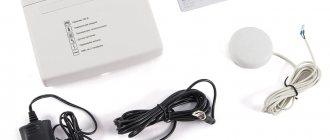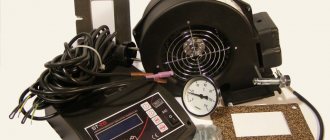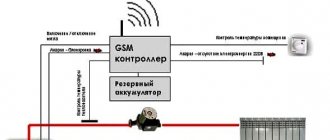Popular models
GSM alarm Sapsan
GSM modules must be selected depending on the type of boiler equipment and the requirements for the controller.
The most famous models are:
- Xital GSM with modifications 4T, 8T and 12T.
- Sapsan Pro 6 – for any boiler equipment, connection of 10 rooms.
- Telcom 2 – only for De Dietrich, up to 5 numbers.
- Vitocom 100 – only for Viessmann, a maximum of two numbers can be connected.
- Logomatic PRO GSM – only for Buderus, maximum number of numbers – 16 pieces.
Control system "Xital"
In the market of GSM alarms for heating equipment, the undisputed leader is the Xital system.
This is a powerful, comprehensive remote control system because in many cases it covers not only heating, but also home security.
The module accumulates data on the temperature in the room, pool, pressure in the circuits, collects readings from safety sensors, and simultaneously regulates the room temperature within a given range.
GSM module for boiler Xital 4T
There are several modifications of Xital - GSM-4T, GSM-8T and GSM-12T. They differ in the number of control zones - 4, 8 and 12.
Each device has an analog temperature sensor, as well as five external digital sensors that continuously measure temperature. 30 seconds after the sensors are triggered, Xital will send a message to telephone numbers (you can configure the equipment to turn off when an alarm is triggered).
Users can register up to 10 numbers, including regular landline numbers.
Startup order
The initial launch of the system is quite simple, you just need to follow the sequence of actions:
- Insert a clean SIM card into the controller.
- Plug in the power adapter.
- Call your mobile phone to the number of the inserted SIM card.
The controller creates initial settings and templates for voice dial-up mailing lists; using Caller ID, your phone number will be entered into them. System startup is complete.
After about a minute, you can do a control check. To do this, call the controller's SIM card again. After the call is reset, you should receive a response SMS message with information about the temperature in the boiler and in the room, the state of the controller inputs, the presence of a network and the protection of the object.
The Xital package includes a battery, with which the module can continue to operate when disconnected from the electrical network. We recommend that you purchase an uninterruptible power supply for your gas boiler in advance, since the module’s battery only lasts for a short time.
Maximum operating efficiency of the entire system is ensured not only by its optimal connection diagram and the presence of automation, but also by the installation location and technical parameters of the heating batteries. In this sense, vertical heating radiators have many advantages.
Which program to choose for hydraulic calculation of a heating system?
GSM thermostat ZONT H-1
The ZONT H-1 device (GSM thermostat) gives users previously difficult-to-access abilities - remote control of the operation of heating boilers and room temperature. It has small dimensions of 7.7x8.3x3.3 cm, is housed in a durable housing made of ASV plastic, equipped with standard outlets for connecting to boilers and a comfortable panel for mounting. The entire range of Zont equipment is presented on the official website of the Microline dealer - the Teplotorg company: https://teplotorg.ru/kotelnaya/pribory-upravleniya/
GSM module functions
Each specific module has a different number of functions, which depend on:
- the number of channels, and accordingly, sensors that can be connected;
- features of remote control and monitoring;
- ability to adjust heating parameters.
A standard set of sensors scans temperature, pressure, and the presence of carbon monoxide. When setting up auxiliary ones, you will immediately receive expanded functionality. Such sensors can be digital or analog.
- turning on/off the entire heating system;
- the ability to turn the boiler on or off, reboot the device itself or auxiliary devices;
- receiving information about the condition of the boiler daily, information comes in the form of mobile messages. The messages will contain the following data: temperature, equipment operating parameters; in the event of abnormal and emergency situations, they will be immediately displayed;
- remotely changing the settings for the operation of an electric boiler, the temperature intensity in the whole house or in a separate room;
- to avoid connecting third parties to the SIM card, you can set a PIN code;
- control of electrical voltage stability (your unit will be protected from sudden changes in energy);
- The controller operates in autonomous mode (this is provided by the battery). In the event of a power outage, the module will continue to operate on battery power.
In addition to the main functions of the modules, there are a number of auxiliary ones:
- If desired, the user can connect an additional relay.
- Turn on the emergency siren.
- Launching auxiliary equipment and the ability to control it remotely using a gadget.
Room thermostat Protherm ZONT H-1V
Features of operation
Automatic boiler control can be installed on any boiler, regardless of the fuel used. When installing a GSM boiler control module, the operating features of each type of boiler are taken into account, the operating mode of the equipment and resource consumption are optimized.
- In pellet boilers (which use wood pellets as fuel), the device can automatically adjust the fuel supply to the firebox; the system will signal a power outage or burner extinguishment.
- During operation of electric boilers, the controller will monitor the voltage in the system and give alarms in the event of a sharp decrease in power.
- Diesel boilers are most often used for heating large industrial premises, and the equipment itself can combine several units. The GSM module for heating boilers allows you to combine incoming information about the condition of boilers in one center, reducing the maintenance staff to 1 person. The system will regularly, timely send signals about the need to refill the tanks.
GSM-Thermometer – module for remote control of boilers.
What are GSM modules for heating boilers?
A GSM module is a small device (controller), which essentially represents an alternative to boiler controls and automation. It receives a signal via cellular communication and transmits a command to the boiler or in the opposite direction: it informs about the status and operating parameters of the boiler and the heating system as a whole.
Why is it needed and how is it used
Typically, the primary purpose of purchasing a device is to save money and increase the operating comfort of the heating system. Any GSM module allows:
- turn the heating boiler on or off completely;
- control the temperature, for example, lowering the temperature during absence in order to significantly save money and restoring a comfortable mode even before arriving at home;
- manage DHW circuit temperature parameters;
- External temperature sensors included with almost any modern module allow you to more accurately maintain the temperature by measuring the air temperature in the room, rather than the temperature of the coolant. It is also possible to organize weather-dependent operation of the boiler.
But no less important, in our opinion, and indeed a higher priority for some buyers, is safety. The GSM module is capable of notifying:
- about reaching the lower or upper specified temperature limit;
- about turning off the heating boiler due to lack of electricity or gas supply, problems with the removal of combustion products, automation errors, depressurization of the system, etc. This is often a rather underrated feature that allows you to have peace of mind during long-term departures and, in the event of a malfunction, take timely measures to prevent freezing and damage to the heating system;
- It is possible to configure alerts about temperature and other boiler parameters at a certain frequency.
An example of an SMS report on the status of the heating system of the EctoControl module. Notifications and control from the phone can be carried out using SMS and, depending on the functionality of a particular model: through a special application, web interface or voice commands. The GSM module can be connected to any boiler that has the ability to connect external control (having the appropriate terminals), both gas, electric or liquid fuel, and solid fuel.
Message about a malfunction of the boiler using the example of the ZONT H-1V module application.
Almost all modern models allow you to bind at least 2, but usually up to 5 or 10 numbers to the controller and report on each of the linked ones. Modern devices, due to the ability to connect other modules to them, allow you to organize even wider functionality: monitoring the level of liquid and even solid fuel (for example, pellets in an automatic feed hopper), monitoring the status of flow and carbon monoxide sensors, monitoring pressure in the circuits.
Design and principle of operation
The main element is the controller (electronic control board). It has a slot for a SIM card, without it the device will not work. Depending on the planned method of management and control, it is necessary to select the most profitable cellular operator and tariff, and constantly maintain the operation of the SIM card by topping up the account. Regardless of the method of transmitting the command, the controller receives it via cellular communication and converts it into a command for the boiler, which has priority over the operation of standard automation.
To improve communication quality, the controller can be supplemented with an antenna. To ensure uninterrupted operation during a power outage, most models are equipped with a built-in battery, so they can easily send an alert about the problem. Almost all modern models come with external temperature sensors (wired and wireless), information from which takes priority over measurements from boiler sensors.
How to choose and connect a generator for a gas boiler correctly
Programmers and thermostats are the main heating control elements
Heating programmer
To organize autonomous heat supply, you will need electronic devices. They may have a heating boiler control panel and the ability to simultaneously change steam meters in several connected components.
These devices are called programmers or electronic thermostats. Like other similar devices, they can have heating control via SMS or the Internet. But these are just additional functions. To select the optimal model, you need to know the basic functional qualities of the programmer:
- Number of connected circuits. Can vary from 1 to 12. An additional module is installed to increase the number of connectors;
- System operating modes. Depending on the settings, you can set the control of heating radiators in economy, normal and comfortable modes;
- Plug-in module – heating control by phone. The GSM station transmits the required information via SMS - coolant temperature, emergency mode notification, etc.;
- The presence of radio transmitters to create wireless communication channels between connected heating components.
Connecting the programmer to the boiler
But in addition to local devices, there are also zonal ones, installed on specific components - boilers, radiators. By controlling heating via the Internet using these devices, you can regulate the degree of water heating in the system and the temperature regime in a specific battery. Often such devices are called not programmers, but electronic thermostats.
They are more affordable and easy to install. Thermostats do not require a heating control cabinet, which reduces the complexity of installation. In some cases, it is possible to connect several thermostats to a single control unit.
What should you consider when creating a smart heating budget? In addition to the cost of the control element, you need to know the approximate price of consumables - communication wires, heating control panel. The latter is necessary when installing a system consisting of several blocks - a programmer, a GSM module, expansion strips for additional contactors.
| Model | Purpose | Cost, rub. |
| Computherm Q3 | Wired thermostat | 1625 |
| Computherm Q3 RF | Wireless thermostat | 3367 |
| PROTHERM Kromschroder E8.4401 | Programmer. Control of 4 boilers, DHW, 15 heating circuits | 34533 |
| Heating control panel | RCD, boiler control units, connection to temperature sensors | From 7000 |
It is also important to consider the location - the heating control box should be installed in an accessible place. Its installation in a boiler room is not recommended, although this is the simplest option in terms of labor intensity.
It is best to install it in a living room. Then it will be possible to monitor and change system parameters much more often.
How to choose a GSM module for a boiler
When choosing a notification module, it is important to pay attention to its functionality and technical characteristics:
- Control – settings are made using buttons on the touch panel and SMS commands sent from the phone. Programmers from leading manufacturers are controlled by special software. The companies Viessmann and Buderus produce programs for Android and iOS that allow you to quickly remotely access the boiler.
Equipment - depending on the selected model, the module is equipped with an automatic gas control system and remote room temperature sensors.
Number of control channels – this parameter determines how many temperature sensors and other equipment can be connected simultaneously. Standard models have two channels, one is used to connect a remote programmer for remote control of a gas boiler via GSM, the second is used to transmit signals via SMS messages.
Microprocessor - budget models of control units, have only a few simple functions and fixed operating modes. Premium class equipment, has a built-in weekly programmer for controlling the temperature of the gas boiler using GSM.
Battery – the control unit operates from the mains. In the event of a power failure, power is automatically switched to the battery. The battery capacity should be sufficient to ensure autonomous operation of the module for several hours. If power outages occur frequently, choose a battery with a larger capacity.
When choosing a module, they are guided by the recommendations of gas equipment manufacturers.
Cost of GSM remote control for boilers
A gas heating boiler with a GSM remote control module consumes up to 30% less gas. The initial costs of installing a remote controller will pay off within the first heating season. The cost of the remote control, depending on the chosen model and configuration, varies from 5-12 thousand rubles.
Some manufacturers of gas equipment offer consumers boilers with a built-in GSM control unit. In this case, you will need to buy remote room thermostats and configure them to operate the module.
How to install a GSM module on a boiler
It is not difficult to organize control over the operation of the boiler yourself. To do this you will need to do the following:
- Using special connectors, connect the control unit to the boiler controller.
Insert the SIM card into the slot. To prevent third-party users from connecting, set a PIN code.
Enter all phone numbers to which alerts will be sent.
After completing all the manipulations, a verification code is sent from the phone, and in response you will receive a message about the operating parameters of the boiler. The information received will show that the unit is connected.
It is recommended that the installation of the remote control and GSM unit be carried out by qualified specialists - electrical engineers. Independent work is carried out at your own peril and risk, and is the reason for refusal of warranty service.
Remote control of the boiler using multifunctional thermostats
When the house has an outdated heat supply system without any hint of the ability to connect electronic units, there are no three-way valves and other automatic equipment - you can buy universal thermostats on the market that can easily be combined into a branched system into many zones with the ability to control heating via the Internet.
The kit of such equipment includes an electronic controller, where all settings for each zone take place.
It doubles as a WI-FI transmitter-receiver and through this channel “communicates” with electronic thermostats installed on each battery.
Remote control of the boiler using a Vaillant programmer
It has a separate channel connection with the boiler shutdown unit. Heating parameters can be changed either on the controller itself manually or via the Internet.
Installation issues
If previously the GSM module was available only for electric heaters, today it is installed on boilers of any type.
The differences lie in the connection of the hardware that controls the continuity of the supply of electricity or fuel. For example, when installing on a diesel heater, you should connect a fuel level sensor in the tank.
You can do this yourself, but it’s better to play it safe and entrust the work to a specialist. A specialist will competently perform installation, which will ensure trouble-free operation of the device for a long time.
Connection rules:
- The GSM module is installed in rooms with normal humidity.
- It is positioned so that the transmission of GSM signals is not interfered with by reinforced concrete structures.
- The GSM module is connected to the electrical network through a residual current device (RCD).
Setting up a GSM module via the website
The software in the smartphone is installed taking into account the operating system and updated. Before first use, insert the SIM card and enter the PIN code. The GSM module itself will prompt you to create an access code.
It is recommended that two people perform the functionality check. One person remains next to the boiler for control. Another goes outside and gives commands via SMS. The speed of receiving commands and the device’s response is recorded.
What systems can be controlled remotely
The possibility of automatic heating control is available when we are talking about autonomous two-pipe systems with forced coolant circulation. This means that the boiler is equipped with a circulation pump or such a pump is additionally built into the supply or return. In this case, maximum efficiency is achieved in systems with a collector (distribution comb).
GSM control modules allow you to control not only the heating boiler, but also other systems
This requires retrofitting the system with a safety unit that operates in auto mode. It is able to prevent negative consequences from gusts caused by excess pressure. If overheated, high-pressure steam is released through an emergency valve.
Remote control of the heating boiler, in addition to the control board, includes:
- devices that measure the temperature of water in the system;
- Pressure Sensors;
- devices that control water level.
There are also more complex models that are capable of adjusting the operation of the system to changing weather. For this purpose, additional sensors are installed on the street. All this hardware is controlled by a microprocessor with certain software. It is the programs that make up the bulk of the cost, since the equipment is not that expensive.
The remote control system includes temperature sensors, shut-off and control valves
All this equipment for remote control of the heating boiler is additionally installed in the heating system. It can be installed either during the installation of the system or “built into” an already finished one. Just keep in mind that to retrofit existing heating, major alterations are necessary - you will have to build in sensors and control/shut-off devices (valves).
Rating: Manufacturers and models of GSM modules
A mobile phone can be used as a remote control in a remote access system. To do this, just insert the SIM card into your mobile phone and connect it to the boiler.
Each device contains instructions for use, as well as instructions for installing the module
To purchase such a module yourself, it is recommended to pay attention to the rating. It presents a selection of models for home use from various manufacturers
In addition to them, devices from the companies Wolf, Baxi, Buderus, Navien, Protherm, Vaillant are considered good products.
"Kotel OK"
The most popular on the market, one of the best and most inexpensive GSM modules for heating boilers made in Russia. In addition to the price, it is distinguished by its compact size, extremely simple and easy setup, and the presence of an application that can send commands, including in the form of SMS, which is an excellent option that allows you not to use tariffs with Internet access.
The functionality of the device is quite simple, the minimum required: temperature control, setting alerts, checking boiler operating parameters, and the module also has a built-in relay that allows you to turn the boiler on and off.
Among the disadvantages, it is worth noting a rather simple application with the minimum required functionality and an outdated interface, the presence of an external temperature sensor with a cable length of only 0.5 meters, which does not imply its installation in other rooms remote from the boiler room. The antenna is also not remote, screwed into the device via a threaded connection.
Cost: 3,990 rub.
XITAL GSM 4T
Another well-known, more professional and versatile device with a much richer package. The heating control functionality in it is approximately the same as in the previous “Boiler OK” - the minimum required, however, there are as many as 4 zones for additional devices (flow sensor, smoke sensor, motion sensor, flood sensor, door opening sensor, etc.). Also included is an electronic key and a reader (similar to those installed in intercoms), so you can influence the settings, if desired, only with an electronic key.
The main difference is the presence in the kit of two remote temperature sensors with a wire length of 10 m, as well as a remote wired antenna and a cord for connecting a backup external battery (unfortunately, there is no built-in one). Management and control can be carried out both via SMS and through the application.
The disadvantages, in addition to the lack of a built-in battery, are the ineffective and inconvenient, although understandable, application interface, less attractive appearance with exposed terminals and large dimensions
Please note that for heating you must choose a model with a “T” at the end
Cost: 8,640 rub.
EVAN GSM CLIMATE
Also known as ZONT H-1, it features a more modern and convenient application, with ready-made “Economy” and “Comfort” modes, as well as the ability to program boiler operating parameters. It is enough to configure the boiler operating pattern once and the module will automatically issue commands to the boiler to change parameters depending on the time or day of the week. Control via a web interface is also available. The standard package includes one remote temperature sensor and a remote antenna.
Perhaps the only drawbacks are the lack of a built-in battery and only one contact for connecting an external temperature sensor.
Cost: 6,780-8,840 rub.
ZONT H-1V
A more advanced analogue of the previous GSM CLIMATE (ZONT H-1). Despite its less attractive appearance, it has an additional “Anti-Freeze” mode and a built-in battery for autonomous operation during power outages. Number of connected temperature sensors – up to 10 pcs.
Otherwise, due to the same firmware, everything is similar to the previous model: the same control via SMS, application or web interface, which, by the way, is one of the most convenient and functional, with statistics. The kit still includes one remote temperature sensor and a remote wired antenna.
Cost: 7,400-9,200 rubles.
What is included in the GSM kit
The contents depend on the manufacturer and model of the product. The following parts are included as standard.
Controller (GSM module) is a device with a different number of inputs, expandable if you need to connect additional functions. Models in the low price segment contain a couple of standard functions and operating modes. More expensive devices have a pre-built control regulator for a week.
Portable temperature sensors, from two to ten - it depends on the type of module. Designed for different rooms, including outdoor ones. The optimal number is five, provided that one of them will be on the street.
Standard type of heat sensor (outdoor and room) for regulating temperature indicators in the entire house or in certain rooms
A GSM antenna is required to strengthen the signal. She is responsible for establishing uninterrupted communication with the owner of the equipment and with the towers of the cellular operator.
Through a relay (in most models up to 3 pcs.) feedback is provided to the owner. In the user manual for all modules there is a list of codes that characterize all normal and abnormal situations and codes for feedback.
Standard equipment of the gsm module using the example of the 4T model from . All components are connected and prepared for installation (+)
Additional sensors (such as motion and fire) are also required. More often, users independently purchase them depending on their needs.
The battery may be additionally present in some models. Manufacturers most often use lithium-ion. This is an important component because battery life depends on it. If the voltage is turned off, the power will automatically transfer to the battery.
The battery capacity should be enough for full operation of the GSM module for at least five hours, preferably up to two days. If you know that power outages occur frequently in your area, then it makes sense to purchase a battery with a larger capacity.
The master key prevents third parties from interfering with the heating system and removes the locks you have set.
Touch memory electronic key reader in the Xysal GSM module model. Used to protect against unauthorized intervention in boiler control
In addition, the kit includes an electronic key reader, a touch screen, connectors for connecting to the boiler, and coils of connecting wires. If necessary, you can purchase additional components or “assemble” the set to suit your needs.
Equipment and functions of the device
Different manufacturers have different equipment packages. The range of functions depends on the device modification.
The standard unit has the following elements:
- GSM controller or module. This is a device with many inputs and the ability to connect additional functions. Budget modifications have only a few standard operating modes and functions. An expensive home heating control controller has a built-in control regulator that allows you to set boiler operating parameters for a week in advance.
- Portable temperature sensors are installed in different rooms. There are also external sensors. Their number varies from 2 to 10 and depends on the type of module. In an ordinary residential building, five sensors are enough, and one is installed outside the building.
- The GSM antenna allows you to strengthen the signal and ensure continuous communication with the user and cellular network towers. To implement feedback with the owner, relays (no more than three pieces) are installed. The device comes with a user manual, which indicates feedback codes, as well as normal and emergency situations.
- Some units are additionally equipped with a lithium-ion battery. The duration of independent operation of the equipment depends on this device. In the event of a power outage, the device automatically switches to battery operation. The minimum capacity of this device should be enough for 5 hours of operation of the device. The best option is autonomous operation for up to two days.
- The master key is needed to ensure that outsiders cannot interfere with the system. Only with its help you can remove the installed locks.
Depending on needs, users can purchase additional fire or motion sensors, which are also needed in the house during the absence of the owners. The package also includes connecting wires, blocks for connecting to heating equipment, a touch screen, and a device for reading electronic keys.
The device has the following basic functions:
- It is used to start and stop the heating system.
- Remote control of the boiler. You can turn on, turn off and restart heating equipment, as well as other devices in heating networks.
- The user can change the operating parameters of the heating equipment by sending an SMS with a specific code.
- The GSM module will regularly send messages to the home owner’s mobile phone with information about the condition of the boiler, emergency situations, operating parameters, and temperature conditions.
- If sensors for rapid response to motion, fire or flooding are connected, then notifications about these emergency situations will also be sent. Intelligent systems can shut down equipment themselves due to a gas leak.
- Protection against power surges.
- Autonomous battery operation in case of power outage.
- Increasing the service life of heating equipment by reducing the load on it and timely adjustment of parameters.
There are also additional functions that make using the module much easier:
- To install new sensors, other relays can be connected to the device.
- You can start additional equipment in the heating system and control its operation remotely using a mobile phone.
- In solid fuel heating equipment it is easy to control the pressure.
- When using units operating on liquid fuel, you can monitor the amount of diesel fuel in the tank.
- In pellet boilers you can determine the quality and calculate the amount of fuel in the compartment.
- Additional functions make it easy to check the boiler feeder.
- Smart home heating also allows you to turn on the emergency siren.
After installing additional sensors, the GSM module can monitor movement in the room, for example, after it has been hacked. After installing fire sensors, the unit evaluates the smoke content of the room. Installing a leak sensor will ensure that the water supply to the house is quickly shut off in the event of a leak.
Advantages of remote control systems
First, you need to determine the method of future remote control of the heating boiler by choosing one of two options. In the first case, the boiler is controlled via the Internet, for which you must have an Internet connection. In the second case, this mission is performed by cellular communications, which is more suitable for a home located at a distance from city communications.
Internet control
If you install remote control of a gas boiler using the Internet, you can get a series of additional benefits.
After installing the necessary control elements into the heating system, the following options open up:
- remote control of various functions of the heating boiler, including operating modes of the circulation pump;
- by installing the required number of sensors, you can determine different temperature conditions for several zones;
- remote coordination of hot water supply, in case of installing a double-circuit boiler;
- 24-hour monitoring of the current state of the operating heating system;
- the most economical fuel consumption, because during a long absence there is no need to maintain the usual microclimate.
The indicated advantages constitute only a basic set of possibilities provided for an individual heating system. If desired, control over the internal temperature of the house can be taken to the next level by using a more versatile version that uses an Internet gateway and an automated heating control unit.
In this case, it will be possible to additionally control heating elements, oil radiators or electric convectors. Among other things, the list of systems for remote control of the boiler may include a fire alarm, which will not be superfluous if the house is built of wood.
Cellular control
An alternative to the control unit for the heating system of a country house is a GSM module operating from a cellular network. Remote activation via SMS messages in order to transfer information to the control panel of the water heating boiler has personal advantages:
- small dimensions of the device that interacts with a smartphone;
- mobility – easy to install in any suitable location;
- ease of operation;
- For insurance, you can use two communication lines at once; the device is designed to install an additional SIM card.
This device is used when it is not possible to connect to the Internet. This quality allows the use of a remote control unit for a gas boiler even in remote areas.
Advantages and disadvantages of GSM devices
This is what the client will receive by connecting the GSM module:
Safety. The main purpose of the GSM module is to control the heating system and additional equipment, timely informing about existing or possible breakdowns. By connecting, for example, an additional broken glass sensor, you can quickly react if thieves break into your house.
Comfort. Management of key indicators of heating and related systems without the physical presence of the consumer next to them. For example, when returning home, you can easily preheat the water in the boiler to the required levels or increase the temperature in the entire house by sending one message.
Saving. When no one is home, the temperature can be as low as possible, and you will thus reduce your heat bill by a significant amount. And the absence of constant load on the heating system will help extend the life of the boiler, boiler and other equipment.
The diagram shows all the benefits of the module that its owner receives. They are implemented through proper device settings and correct connection. (+)
Thanks to these three advantages, the commercial attractiveness of the module is formed.
And GSM equipment also has its drawbacks. Fundamental, of course, is the high price of the device.
Users note the need to constantly monitor the cash balance of cellular communications, dependence on the operator’s work and coverage. This is especially inconvenient for owners of houses outside the city or in villages remote from metropolitan areas.
Additional disadvantages include: the complexity of self-connection and additional installation costs.
Installation features from the consumer's point of view
Whoever installs the GSM module (you yourself or a specialist), be sure to make sure that these conditions are met:
- Optimal humidity is maintained at the installation site, as when installing the boiler;
- if there is no portable antenna, then check that there is nothing obstructing the signal transmission, for example, a concrete ceiling;
- pay attention to the length of the antenna cable if you need to take it to another location;
- connect the module when the boiler is turned off and through an RCD in order to protect the equipment from power surges;
- Check in advance that the distance between the temperature sensor and the controller is no more than one hundred meters - for better communication.
At the beginning of work, you must enter the phone numbers to which information will be sent. Then you will receive a verification code in the form of an SMS.
When you purchase a new card, immediately top up your account with at least 300 rubles and ask the operator to turn off all messages with paid advertising so that it does not take up space and confuse the controller. Please note that the cellular operator in the area where such a module is installed must have an uninterrupted signal.
To connect to the module, you can use a SIM card from any cellular operator. The main thing is to make sure the continuity and quality of the signal
After installation, be sure to test the operation of the GSM module. Let someone go outside with the phone, and someone stay in the house. It is important to check how quickly messages will be received when certain changes in boiler operation occur.
The phone receives an automatic SMS report on the status of the boiler and other key indicators of the system. Hints help you set up your equipment correctly
It is also necessary to configure the temperature regime, which is regulated by street and room sensors. Before doing this, please note that the documentation for the boiler indicates the minimum and maximum temperatures at which it will operate without failure.
The room sensor is responsible for the thermal conditions inside the room. In some models it can be set for the whole week. For example, on weekdays, three types of temperature settings are relevant: in the morning and evening - high, because everyone is at home, during the day - low, at night - also low or closer to average for a comfortable sleep.
When the weather changes, the user of the gsm module can remotely change the air temperature in the entire house using a special application on the tablet (phone)
Everyone is at home on the weekend, so choose the heating that is most comfortable for the whole family. This mode is called “general”. If you want to set the temperature in individual rooms, then turn on “zonal”. It is responsible for heating the air in individual rooms.
In the “vacation” mode (the names of the modes differ among different manufacturers), the temperature is at the very minimum. In this case, you can remotely control the autonomous unit to change the temperature.
For example, while on the way home, send an SMS with a special code or simply enter the required number to change the temperature mode.
If plans change, the user can always remotely adjust a comfortable temperature regime and return to a warm home
If a boiler is also connected to the system, then you can change not only the water temperature, but also the heating system. When switching to summer mode, the boiler does not turn off, but operates at minimum power.
Please note that there is an “anti-freeze” mode, which turns on the boiler from time to time to maintain the correct operation of the entire heating system.
The outdoor sensor reacts to changes in temperature outside the window. Experts call this mode the most promising. If the temperature drops, the boiler automatically raises the temperature.
After installation, also test the feedback from the autonomous heating. To do this, send a message with a command code.
When a user sends an SMS with a code (feedback function), he receives a response with performance indicators of the heating system
Technically, communication is realized through a relay, which is directly connected to the gas boiler.
Module connection diagram
The GSM module should be installed at a point from where the necessary sensors and interfaces can be connected using the most optimal route. The following should be taken into account:
- The length of the line to the temperature sensor can be from 1 to 100 meters, depending on the functionality of the module.
- The communication line with the boiler for control (feedback) should be as short as possible, especially if the module will switch the power supply to the boiler.
- There must be cellular coverage at the installation site. As an option, an external antenna is used, then the limitation concerns the cable length.
In any case, the most reasonable thing would be to install it directly next to the boiler. But at a minimum distance of at least 1.5 meters and at a height above 50 cm, so that there is no risk of water entering even in the event of an accident.
The module is connected to the power supply using a separate power line from the panel and terminal block, or simply to the nearest outlet using a wire and plug. The sensors are connected with wires according to the manufacturer's instructions
In this case, it is important to observe the cross-section of the wire and the material from which it is made. Manufacturers often require the use of coaxial cable to connect sensors with full shielding, especially when the remote sensor is located at a considerable distance
The module often contains a set of terminals with symbols under a protective cover. According to the instructions, color or mnemonic markings are used to determine the terminals for connecting sensors, signal and control wires from the heating boiler.
After the wires are connected and placed in a box or protective corrugated pipe, you can begin setting up. The ranges for the sensors are set, the signal lines are set, and the actions that the control device takes when receiving signals are set.
The main point is to set a telephone number or even two to which the module will transmit readings and from which it will receive settings and commands.
ABOUT THE Xital GSM-T LINE
One board, one device, one small device - a special GSM module Xital, which allows remote and automatic access to the heating system, its configuration and control via cellular communications.
It is enough to install Xital once, connect it to the boiler, and it will stably monitor its operation 24/7. It is worth saying that the functionality of the device is not limited to just turning the heating on and off; you also get a number of other features.
Possibility of adjusting air temperature. You set the command to what degree to heat the house and you can be sure that it will be exactly as warm as you wanted. And when you're not at home, save up to 30% on heating costs by simply lowering the temperature of your heating system.
Versatility. Xital controls the temperature of the premises, protects your home, and reports the presence or loss of voltage in the 220 V network.
Monitoring the operating status of heating equipment. If any problems arise, the GSM module will definitely inform you about it.
Basic operating modes
There are several control modes; by choosing one of them you decide at what time and what information you will receive about the operation of the boiler:
- Auto. In this mode, the system operates according to the specified parameters. A complete analysis of the situation in the house and separately heated rooms takes place. At the specified time, you will receive a full report on the operation of the equipment.
- Manual (feedback from the user to the system). The essence of this mode is that users receive SMS messages with a code word to change a particular mode or adjust settings.
- Anxious. In the event of a power failure, smoke, leakage, unstable boiler operation and other emergency situations, you receive an instant notification.
Stable and uninterrupted operation of the heating system is the key to a comfortable environment in a house or apartment. An electric boiler with a GSM module is a modern heating device that allows you to control your home boiler room remotely via mobile communications.
Design and principle of operation of the GSM module for the boiler
In essence, the GSM module is a variation of a mobile phone, since it uses the same communication protocol.
The operating principle of the device is as follows:
- using a SIM card, the device connects to the GSM network;
- then it connects to the smartphone;
- You can send a signal to the device from the gadget;
The module itself consists of the following structural elements:
- Thermostat. Controls the boiler temperature and sends a signal to the owner’s smartphone about its change. Many models allow you to use other notification methods (light, sound signals).
- Fasteners Base for mounting the device. Typically designed for installation on a vertical wall.
- Power unit. The module elements are not designed to work with standard household voltage. Therefore they need a power supply. Typically the operating voltage of the device is 9 V or 12 V.
- Antenna. Allows you to receive signals in the GSM range, with the help of which the module is controlled.
- Sensor. Determines the temperature of the boiler and transmits the received information to the thermostat for further processing and notification to the owner. Most sensors are capable of operating at temperatures from -50 o C to +99 o C. This allows them to be used in almost any conditions.
- Backup power supply. Represents a battery or accumulator. Designed in case of a power outage or power supply failure. Ensures long-term battery life of the device while maintaining full functionality.
Expert opinion Vadim Savelievich Grebnev Heating systems installer
Another essential element of the GSM module for boiler control is the SIM card. After all, it is with the help of it that the device connects to the mobile network. But it will have to be purchased separately. Some manufacturers include a SIM card with a suitable tariff in the kit, but this is rare.
Operating modes
Most existing device models have two operating modes:
- Auto. The owner of the device sets the necessary settings, and the device operates in accordance with them. For example, you can set the boiler to turn off when a certain temperature is reached and turn on again after cooling.
- Manual. In this case, control is carried out completely manually. A smartphone is used for this.
- Anxious. Essentially, this is the same automatic mode. But with one caveat - the system notifies the user in case of emergency situations (for example, an unexpected increase in temperature above permissible values or spontaneous shutdown of the boiler).
Convenience and features
Using this device, you can set the desired room temperature in various modes from anywhere.
- Economy Provides a measured temperature at user-selected low values, for example, 15 C.
- Comfort. Maintains a comfortable temperature of about 22 C. It is used when, for example, aquarium fish, flowers and pets remain in the house in the absence of the owners.
- Schedule. The mode allows you to set heating characteristics in advance for a certain period - a day, a week. Within its framework, in addition to the main four, select a huge number of modes, for example, turning on once a day at a certain time for 2 hours, regardless of temperature, etc.
- Switched off. The boiler can be turned off remotely when it gets significantly warmer outside and the owners are not at home.
READ How to clean the heat exchanger in a gas water heater
Within these main modes, you can set the appropriate temperature with an accuracy of up to 10 degrees. In addition to the modes displayed in the application menu, protection against defrosting of the system is automatically created - the “Anti-Freeze” mode. The temperature at which the coolant in the heating system cannot freeze is set. When using water, this is not lower than 0 degrees; when using antifreeze, the threshold is lower, which additionally saves money on energy costs.
The GSM module provides notification to the owner about all parameters and events in the heating operation. In case of interruptions in power supply, gas supply, or water leaks, the owner receives an SMS with information from the device. Also, the owner of the house can open the application on his tablet, phone or computer at any time and find out what the current temperature is in his house and how well the heating system works.










